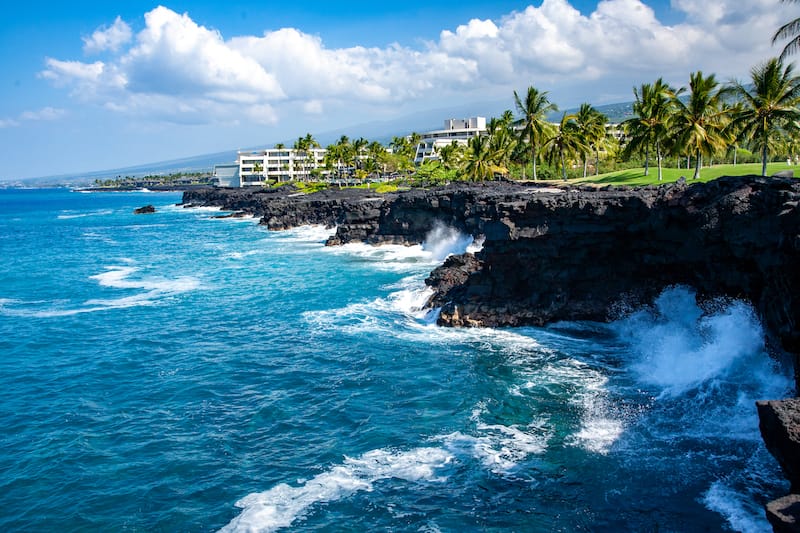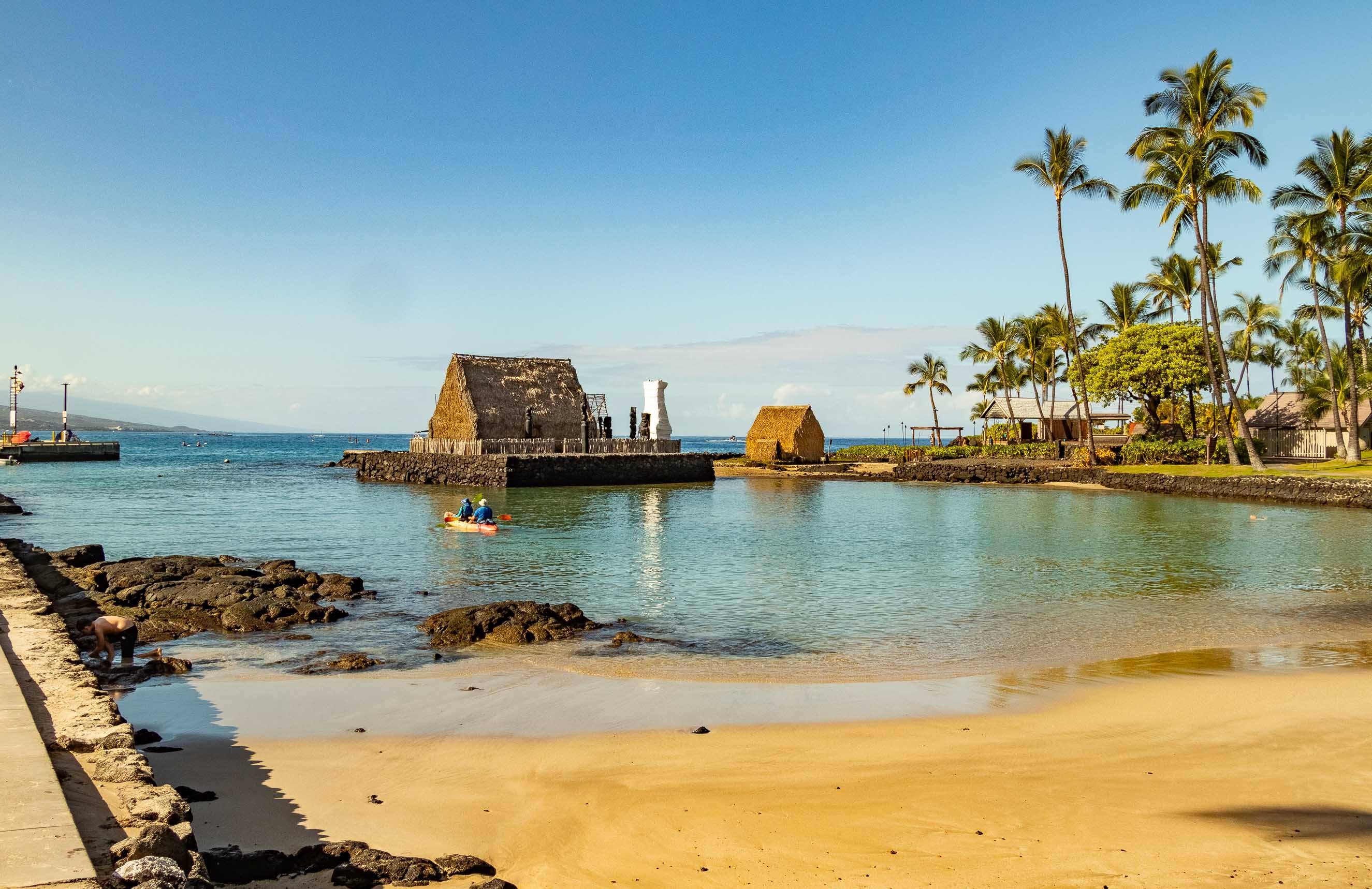Kona Island Geography and Environment

Kona Island, located on the Big Island of Hawaii, is a captivating destination known for its diverse landscapes, unique climate, and rich natural beauty. Its geological origins, diverse ecosystems, and distinct weather patterns contribute to its allure.
Volcanic Origins and Elevation
Kona Island’s volcanic origins have shaped its dramatic landscape. It is formed by the active shield volcano, Mauna Loa, which is one of the largest volcanoes on Earth. The island’s elevation ranges from sea level to the summit of Mauna Loa, which reaches an impressive 13,680 feet (4,170 meters). This dramatic elevation gradient contributes to the island’s diverse microclimates.
Climate and Weather Patterns
Kona Island is renowned for its dry and sunny climate, particularly on its western side, known as the Kona Coast. The island’s location on the leeward side of the Kohala Mountains creates a rain shadow effect, resulting in significantly less rainfall compared to the windward side. The Kona Coast enjoys an average of 250 sunny days per year, with average temperatures ranging from 70 to 85 degrees Fahrenheit (21 to 29 degrees Celsius).
Diverse Ecosystems
Kona Island’s diverse topography and climate support a wide range of ecosystems. The island’s lower elevations are characterized by dry, arid landscapes, including coastal deserts and lava fields. As elevation increases, the landscape transitions to lush rainforests with abundant vegetation and diverse wildlife.
Kona Island Culture and History

Kona Island’s rich cultural tapestry is deeply intertwined with its captivating history, a journey that stretches back centuries. From the arrival of the first Polynesian settlers to its significant role in the Hawaiian monarchy, Kona’s cultural heritage is a testament to resilience, adaptation, and the enduring spirit of its people.
Early Polynesian Settlements and the Birth of Hawaiian Culture
The arrival of the first Polynesian voyagers on Kona Island marked the beginning of a unique and vibrant culture. These intrepid explorers, navigating vast distances using the stars and the currents, brought with them their knowledge of agriculture, navigation, and a deep connection to the natural world. They established settlements, carving out a life in harmony with the island’s diverse ecosystem. Their reverence for the land and sea is reflected in their intricate social structures, spiritual beliefs, and traditions, which have endured through generations.
Kona’s Role in the Hawaiian Monarchy, Kona island
Kona Island played a pivotal role in the history of the Hawaiian monarchy. The island’s fertile lands and strategic location made it a significant center of power and influence. The renowned King Kamehameha I, who unified the Hawaiian Islands in the late 18th century, had strong ties to Kona. He established his royal residence at Kailua-Kona, a town that still bears witness to the island’s historical significance. The legacy of the Hawaiian monarchy continues to resonate in Kona’s cultural landscape, shaping its traditions and values.
Cultural Traditions and Practices
Kona Island’s cultural heritage is rich in traditions and practices that have been passed down through generations.
Hula Dancing
Hula dancing, a captivating form of storytelling through movement and music, is a cornerstone of Hawaiian culture. Each graceful gesture and rhythmic step conveys a story, a legend, or a historical event, weaving together the threads of the past, present, and future. Hula is more than just dance; it is a living expression of the Hawaiian spirit, connecting individuals to their ancestors and their land.
Storytelling
Storytelling has long been an integral part of Hawaiian culture, serving as a means of preserving history, passing on knowledge, and fostering a sense of community. From tales of ancient gods and goddesses to stories of heroic deeds and everyday life, these narratives offer insights into the values, beliefs, and experiences of the Hawaiian people. Storytelling continues to be a vital way to connect generations and keep cultural traditions alive.
Crafts
Hawaiian crafts are a testament to the ingenuity and artistic spirit of the people. From intricate wood carvings to delicate lei making, these crafts showcase the island’s natural resources and the skill of its artisans. Each piece reflects a deep understanding of the environment and a reverence for tradition.
The Influence of Coffee Cultivation
The arrival of coffee in Kona in the 19th century had a profound impact on the island’s economy and cultural landscape. Introduced by missionaries, coffee cultivation quickly flourished, becoming a vital source of income and shaping the island’s identity. The unique microclimate of Kona’s slopes, coupled with the meticulous care of its farmers, produces some of the world’s finest coffee beans, renowned for their rich flavor and aroma. The coffee industry has created a vibrant community, fostering a culture of hard work, dedication, and a deep appreciation for the land.
Kona Island Attractions and Activities

Kona Island offers a diverse range of attractions and activities for every type of traveler. From stunning beaches and volcanic landscapes to rich cultural experiences and exciting adventures, Kona Island has something for everyone.
Popular Tourist Attractions
Kona Island boasts a plethora of attractions, each offering unique experiences and insights into the island’s natural beauty and cultural heritage.
- Kealakekua Bay: This historic bay is renowned for its calm waters, perfect for swimming, snorkeling, and kayaking. It’s also the site where Captain Cook first landed in Hawaii in 1778.
- Pu’uhonua o Honaunau National Historical Park: This park preserves a traditional Hawaiian place of refuge, offering visitors a glimpse into ancient Hawaiian culture and history. The park features ancient temples, petroglyphs, and a scenic coastal trail.
- Hawaii Volcanoes National Park: Although not directly on Kona Island, this park is a short drive away and is a must-visit for anyone interested in volcanism and the raw power of nature. Witness active lava flows, explore volcanic craters, and hike through stunning landscapes.
- Keauhou Shopping Center: This vibrant shopping center offers a mix of local boutiques, art galleries, restaurants, and cultural attractions. Visitors can find unique souvenirs, experience traditional Hawaiian crafts, and enjoy delicious local cuisine.
- Manta Ray Night Dive: Kona Island is a world-renowned destination for manta ray night dives. Witness these majestic creatures gliding through the water as they feed on plankton, creating an unforgettable experience.
Suggested 3-Day Itinerary
A three-day trip to Kona Island can be packed with unforgettable experiences, providing a taste of the island’s diverse attractions.
- Day 1: Arrive at Kona International Airport (KOA) and check into your accommodation. Start your day with a visit to Kealakekua Bay, where you can go snorkeling, kayaking, or simply relax on the beach. In the afternoon, explore the Pu’uhonua o Honaunau National Historical Park, learning about ancient Hawaiian culture and history. Enjoy a traditional Hawaiian dinner at a local restaurant.
- Day 2: Embark on a day trip to Hawaii Volcanoes National Park, marveling at the volcanic landscapes, hiking through the park, and witnessing the power of nature. In the evening, experience a manta ray night dive, witnessing these graceful creatures up close.
- Day 3: Explore the Keauhou Shopping Center, browsing local boutiques, art galleries, and enjoying the vibrant atmosphere. Visit the Kona Coffee Belt, learning about the history and process of coffee cultivation in Hawaii. Indulge in a delicious coffee tasting experience and enjoy a final sunset over the Pacific Ocean.
Accommodation Options
Kona Island offers a diverse range of accommodation options, catering to different budgets and preferences.
| Accommodation Type | Examples | Price Range |
|---|---|---|
| Luxury Resorts | Four Seasons Resort Hualalai, Hilton Waikoloa Village | $400-$1000+ per night |
| Mid-Range Hotels | Sheraton Kona Resort & Spa at Keauhou Bay, Courtyard by Marriott King Kamehameha Kona Beach Hotel | $200-$400 per night |
| Budget-Friendly Hostels | Kona Backpackers, Big Island Hostel | $30-$60 per night |
Kona Island, with its stunning sunsets and vibrant culture, is a popular destination for travelers seeking a taste of Hawaii. And to make your island getaway even smoother, consider flying with alaska airlines hawaii , known for its friendly service and convenient routes.
Once you arrive, explore the charming towns, indulge in fresh seafood, and discover the island’s rich history – Kona Island truly offers a unique Hawaiian experience.
Kona Island, with its volcanic landscapes and lush rainforests, is a haven for nature lovers. If you’re planning a trip, consider taking advantage of alaska airlines bogo deals, which can help you save on flights to the Big Island.
Once you’re there, be sure to explore the historic coffee plantations, swim with manta rays, or simply relax on the white-sand beaches.
